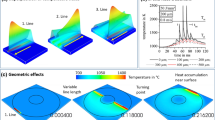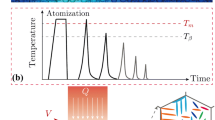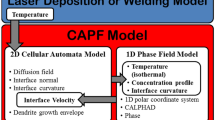Abstract
Hybrid deposition and micro-rolling (HDMR) is a metal additive manufacturing process that integrates arc direct deposition manufacturing and micro-rolling. A two-dimensional cellular automata and finite volume method coupling model is developed for simulating the microstructure evolution of solidification and the dynamic recrystallization during HDMR forming. The influences of different rolling reductions on dynamic recrystallization fraction, average equivalent radius of recrystallized grains, and the area of dynamic recrystallization region are discussed. The results show that solidification microstructure consists of complete columnar dendrite. The rolling reduction plays a dominant role in determining the area of dynamic recrystallization region and the size of recrystallized grains. The average recrystallized grain size at the top position is not affected by rolling reduction, while the influence of rolling reduction on the dynamic recrystallization fraction and average radius of recrystallized grain is found to be stable, but not linear. The same qualitative and quantitative conclusions are drawn from the experimental results as well.















Similar content being viewed by others
References
Hebert RJ (2016) Viewpoint: metallurgical aspects of powder bed metal additive manufacturing. J Mater Sci 51:1165–1175
Edwards P, Ramulu M (2015) Effect of build direction on the fracture toughness and fatigue crack growth in selective laser melted Ti-6Al-4 V. Fatigue Fract Eng Mater Struct 38:1228–1236
Niu HJ, Chang ITH (2000) Selective laser sintering of gas atomized M2 high speed steel powder. J Mater Sci 35:31–38
Zhao J, Zhang B, Li X (2015) Effects of metal-vapor jet force on the physical behavior of melting wire transfer in electron beam additive manufacturing. J Mater Process Technol 220:243–250
Kazanas P, Deherkar P, Almeida P, Lockett H, Williams S (2012) Fabrication of geometrical features using wire and arc additive manufacture. Proc Inst Mech Eng Part B J Eng Manuf 226:1042–1051
Colegrove PA, Coules HE, Fairman J, Martina F, Kashoob T, Mamash H, Cozzolino LD (2013) Microstructure and residual stress improvement in wire and arc additively manufactured parts through high-pressure rolling. J Mater Process Technol 213:1782–1791
Suryakumar S, Karunakaran KP, Bernard A, Chandrasekhar U, Raghavender N, Sharma D (2011) Weld bead modeling and process optimization in hybrid layered manufacturing. Comput Aided Des 43:331–344
Wang F, Williams S, Colegrove P, Antonysamy AA (2013) Microstructure and mechanical properties of wire and arc additive manufactured Ti-6Al-4V. Metall Mater Trans A 44:968–977
Zhang H, Wang X, Wang G, Zhang Y (2013) Hybrid direct manufacturing method of metallic parts using deposition and micro continuous rolling. Rapid Prototyp J 19:387–394
Tian YX, Wang G, Yu S (2015) Microstructure characteristics and strain rate sensitivity of a biomedical Ti–25Nb–3Zr–3Mo–2Sn titanium alloy during thermomechanical processing. J Mater Sci 50:5165–5173
Rappaz M, Gandin CA (1993) Probabilistic modelling of microstructure formation in solidification processes. Acta Metall Mater 41:45–360
Nastac L, Stefanescu DM (1997) Stochastic modelling of microstructure formation in solidification processes. Modell Simul Mater Sci Eng 5:391–420
Nastac L (1999) Numerical modeling of solidification morphologies and segregation patterns in cast dendritic alloys. Acta Mater 17:4253–4262
Wang W, Lee PD, Mclean M (2003) A model of solidification microstructures in nickel-based superalloys: predicting primary dendrite spacing selection. Acta Mater 51:2971–2987
Luo S, Zhu M, Louhenkilp S (2012) Numerical simulation of solidification structure of high carbon steel in continuous casting using cellular automaton method. ISIJ Int 52:823–830
Pavlyk V, Dilthey U (2004) Simulation of weld solidification microstructure and its coupling to the macroscopic heat and fluid flow modeling. Modell Simul Mater Sci Eng 12:S33–S45
Zhan X, Wei Y, Dong Z (2008) Cellular automaton simulation of grain growth with different orientation angles during solidification process. J Mater Process Technol 208:1–8
Chen S, Guillemot G, Gandin CA (2014) 3D coupled cellular automaton (CA)–finite element (FE) modeling for solidification grain structures in gas tungsten arc welding (GTAW). ISIJ Int 54:401–407
Hesselbarth HW, Göbel IR (1991) Simulation of recrystallization by cellular automata. Acta Metall Mater 9:2135–2143
Goetz RL, Seetharaman V (1998) Static recrystallization kinetics with homogeneous and heterogeneous nucleation using a cellular automata model. Metall Mater Trans A 29:2307–2321
Goetz RL, Seetharaman V (1998) Modeling dynamic recrystallization using cellular automata. Scr Mater 38:405–413
Raabe D (1999) Introduction of a scalable three-dimensional cellular automaton with a probabilistic switching rule for the discrete mesoscale simulation of recrystallization phenomena. Philos Mag A 79:339–2358
Ding R, Guo ZX (2001) Coupled quantitative simulation of microstructural evolution and plastic flow during dynamic recrystallization. Acta Mater 49:3163–3175
Lan YJ, Xiao NM, Li DZ, Li YY (2005) Mesoscale simulation of deformed austenite decomposition into ferrite by coupling a cellular automaton method with a crystal plasticity finite element model. Acta Mater 53:991–1003
Kugler G, Turk R (2006) Study of the influence of initial microstructure topology on the kinetics of static recrystallization using a cellular automata model. Comput Mater Sci 37:284–291
Xiao N, Zheng C, Li D, Li Y (2008) A simulation of dynamic recrystallization by coupling a cellular automaton method with a topology deformation technique. Comput Mater Sci 41:366–374
Han F, Tang B, Kou H, Li J, Feng Y (2013) Cellular automata modeling of static recrystallization based on the curvature driven subgrain growth mechanism. J Mater Sci 48:7142–7152
Chen F, Qi K, Cui Z, Lai X (2014) Modeling the dynamic recrystallization in austenitic stainless steel using cellular automaton method. Comput Mater Sci 83:331–340
Han F, Tang B, Kou H, Cheng L, Li J, Feng Y (2014) Static recrystallization simulations by coupling cellular automata and crystal plasticity finite element method using a physically based model for nucleation. J Mater Sci 49:3253–3267
Luo S, Zhu MY (2013) A two-dimensional model for the quantitative simulation of the dendritic growth with cellular automaton method. Comput Mater Sci 71:10–18
Kremeyer K (1998) Cellular automata investigations of binary solidification. J Comput Phys 142:243–262
Mecking H, Kocks UF (1981) Kinetics of flow and strain-hardening. Acta Metall 29:1865–1875
Kugler G, Turk R (2004) Modeling the dynamic recrystallization under multi-stage hot deformation. Acta Mater 52:4659–4668
Humphreys FJ, Hatherly M (1995) Recrystallization and related annealing phenomena. Pergamon Press, Oxford 17
McQueen HJ (2004) Development of dynamic recrystallization theory. Mater Sci Eng A 387:203–208
Roberts W, Ahlblom B (1978) A nucleation criterion for dynamic recrystallization during hot working. Acta Metall 26:801–813
Song KJ, Dong ZB, Fang K, Zhan XH, Wei YH (2015) Acceleration of regeneration treatment for nanostructured bainitic steel welding by static recrystallisation. Mater Sci Technol 30:700–711
Jin Z, Cui Z (2010) Investigation on strain dependence of dynamic recrystallization behavior using an inverse analysis method. Mater Sci Eng A 527:3111–3119
Read WT, Shockley W (1950) Dislocation models of crystal grain boundaries. Phys Rev 78:275
Guo BF, Ji HP, Liu XG, Gao L, Dong RM, Jin M, Zhang QH (2012) Research on flow stress during hot deformation process and processing map for 316LN austenitic stainless steel. J Mater Eng Perform 21:1455–1461
Liu XG, Ji HP, Guo H, Jin M, Guo BF, Gao L (2013) Study on hot deformation behaviour of 316ln austenitic stainless steel based on hot processing map. Mater Sci Technol 29:24–29
Acknowledgements
This work was supported by the National Natural Science Foundation of China (Grant Nos. 51175203, 51374113 and 51505210).
Author information
Authors and Affiliations
Corresponding author
Ethics declarations
Conflict of interest
The authors declare that they have no conflict of interest.
Rights and permissions
About this article
Cite this article
Zhou, X., Zhang, H., Wang, G. et al. Simulation of microstructure evolution during hybrid deposition and micro-rolling process. J Mater Sci 51, 6735–6749 (2016). https://doi.org/10.1007/s10853-016-9961-0
Received:
Accepted:
Published:
Issue Date:
DOI: https://doi.org/10.1007/s10853-016-9961-0




